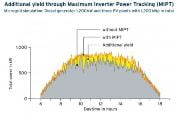The microgrid specialists at DHYBRID have introduced a new technology that lowers energy costs for stand-alone grids by achieving significantly greater solar yields. Simply by improving system management, the recently patented inverter control system can increase the proportion of solar power by more than 10%, with corresponding reductions in the amount of power required from diesel generators or other connected power grids.
The Maximum Inverter Power Tracking (MIPT) system achieves these results by swiss replica watches continuously adjusting the output of individual inverters or groups of inverters in accordance with the needs of the microgrid.
An infographic is available here: https://www.dhybrid.de/en/press-article/patented-new-dhybrid-technology-lowers-costs-and-increases-the-proportion-of-solar-power-in-microgrids
Higher yields from new and existing systems
Conventional microgrid control systems treat all inverters the same, assigning them an identical maximum feed-in rate – which could be a fixed percentage of their nominal capacity. This means that within a microgrid, PV systems that are producing high yields at any given time are treated the same as those that are not performing as well. The resulting power output losses are entirely avoidable and can have significant effects for microgrids in particular. Microgrids often comprise several PV systems that are all connected but may experience different degrees of shading, for instance.
The MIPT system ensures optimal control by continuously monitoring the outputs of the various PV systems, thereby allowing the maximum feed-in capacity to be dynamically distributed across all connected inverters several times per second. Systems that are running better can feed in more energy, making it possible to take full advantage of the photovoltaic output.
“A similar approach has been used to optimize performance between the PV module and inverter. Our technology takes this to the next level and optimizes the performance of individual inverters within a hybrid system. This allows us to significantly improve efficiency and increase potential savings,” explains Tobias Reiner, CTO at DHYBRID.
“In some cases, we have been able to increase the proportion of PV in our systems by more than 10%,” Reiner adds. To save costs, the new technology relies solely on the MIPT algorithm in the DHYBRID software. Since neither special inverters nor other energy producers are needed, the innovative solution can be used to optimize both new and existing systems.
A positive side effect of employing the dynamic inverter control system is that the output of connected diesel generators does not need to be adjusted as often. When generators run steadily, their efficiency and service lives improve, an effect that is clearly evident in the substantially smoother feed-in curves.
Especially beneficial when inverters fail breitling replica watches
The operating principle and the advantages of the new control system become even clearer when an inverter fails. Conventional approaches would treat the defective inverter as if it were still functional, even though it can no longer deliver any yields. By contrast, the MIPT system assigns the remaining systems a higher maximum output power so that they automatically compensate for part of the shortfall.

